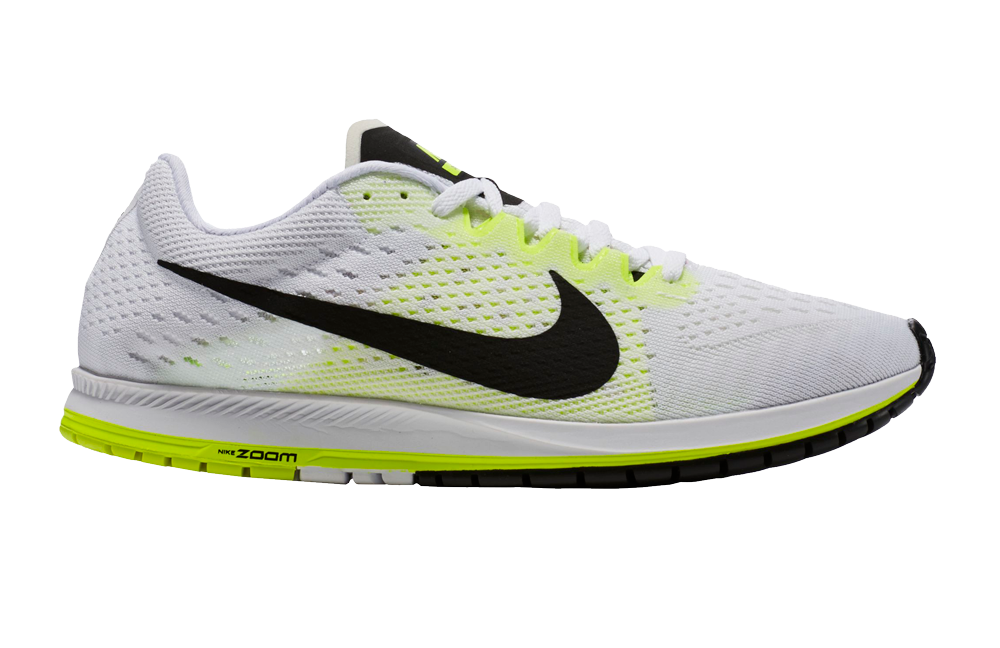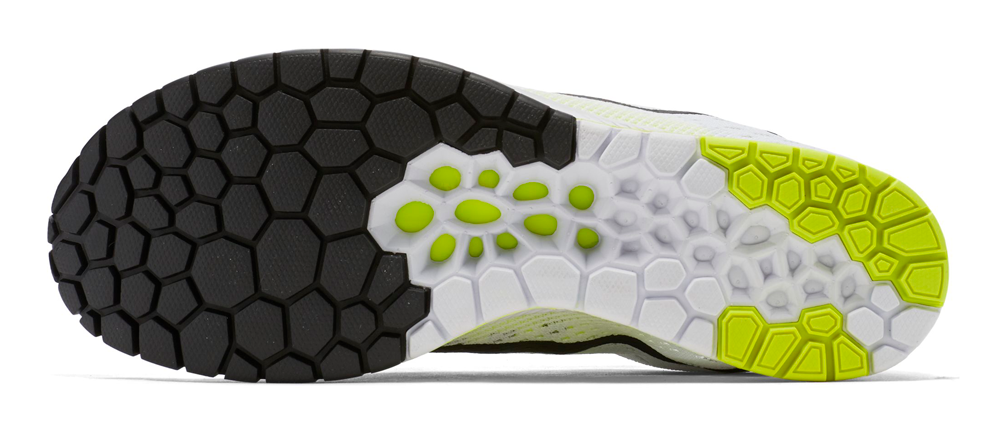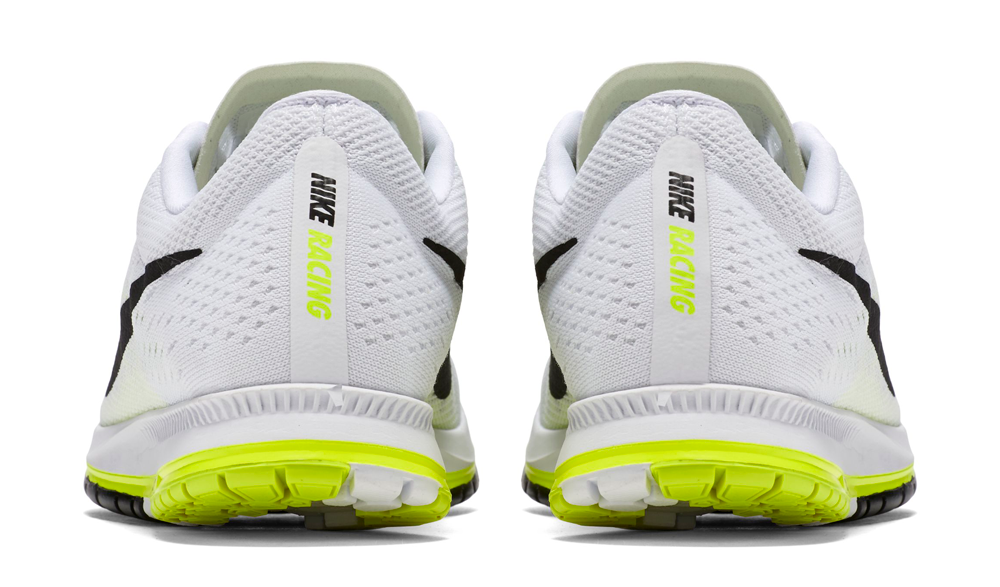
Guest Post by Brian Shelton
I’ve experimented with a lot of racing flats, and here’s what I’ve learned…no shoe is perfect. It seems there is always a compromise of some sort. Being that the Nike Streak 6 was designed based on the input and needs of some of the best marathoners in the world, it is made to be both fast and protective. It is minimal enough to allow some very fast running, but substantial enough to let you relax a bit so your pace is more sustainable.
I’ve done five track workouts in the Nike Streak 6 (paces ranging from 4:00 to a little over 5:00): 16×400, combo session of 800s & 200s, 8×200, 10×500, 10×800, and another 8×200.
I’ve also done six road sessions in the Nike Streak 6 (paces ranging from 5:17 to 5:25): 5k tempo, session of 3M/2M/1M/1M, 5M tempo, session of 1M/4×400/1M, 4M tempo, 8k road race.

The Nike Streak 6 feel light. The feeling of lightness was so convincing that I actually had not even weighed them until writing this paragraph. I weighed them on the same non-digital food scale that I’ve weighed my other shoes on. At 7oz for my men’s size 10.5, they are ½ an ounce lighter than my LunaRacer or Streak 5 and a little over an ounce heavier than the New Balance 1600 or Streak LT2 (I haven’t weighed my LT3). It is approximately the same, maybe ¼ of an ounce heavier, than the New Balance 1400v3.
They’re responsive. These babies can get up and go! Compared to the LunaRacer, the Streak 6 feels much less removed from the road. Relative to the Streak 4 and 5, the Nike Streak 6 is much less squishy in the heel. I’ve had a lot of success with both the LunaRacer (half marathon PR) and Streak 5 (marathon PR), but the Streak 6 really feels more dialed in for aggressive running. I like the increased firmness relative to the other two Nike racers. It’s without a doubt protective enough for a marathon, but when you really want to get after it and run your most aggressive paces, the Streak 6 feels like a much better tool for the job. If I were going out for a long run at moderate paces, I’d still choose the LunaRacer, but if I am going to do a real workout or a race (anything from 5k to marathon), the Streak 6 is easily the better choice. A true speedster, especially those with an extensive or recent track background, might prefer a thinner or lighter shoe for shorter races like the 5k and 10k, but I doubt he/she would ever complain that these are squishy. I have never once felt inclined to label these as such, which is something I occasionally struggled with on the old Streak 5. For me, these strike a perfect balance between cushioning and responsiveness.
They lace up well. The lacing system used here, previously seen on the Streak LT, is wonderful. I’m not saying Flywire is bad. It works great on the Pegasus, but I would personally be thrilled if the system used here were used in all Nike trainers (it was used, with stiffer materials, in the old Vomero 8). The wrap system seems to do a better job of really locking you in, while still being accommodating for variations in foot shape and/or volume. I get no weird pressure points, and I never feel loose like I did in the Flyknit Racer. There is enough room in my forefoot so that I don’t get those annoying blisters on my pinky toe (I’m looking at you New Balance 1600!), but things are snug and secure in the midfoot and heel. If you’re going to run fast, you need a shoe that feels securely attached to your foot. The Streak 6 succeeds here, and I suspect it will do so for a lot of different foot shapes.
They’re durable enough for a racing flat. I’ve done a fair amount of running in these so far. I’m not going to go to the trouble of adding up the miles, but in addition to the workouts mentioned above, I’ve also worn them for the strides/drills portion of my warmups and sometimes for a mile or so of my cool down if I finished my workout away from my house or car. The wear seems visually appropriate for a racing flat, and more importantly, they still feel good!
They’re versatile. The tricky thing about choosing a racing flat is finding a shoe that threads that needle between feeling aggressive yet also allowing you to feel like your effort is sustainable. This balancing act becomes more important as the distance of your race increases. A lot of shoes feel great for the marathon or half marathon, only to be a bit cumbersome at more aggressive paces. Being that I have primarily focused on the half and full marathon for the past 2-3 years, I have tended to wear my marathon shoes for those faster workouts and races, because they allowed me to put in the work, without getting beat up, and hopefully recover quicker. That said, I always felt like I was leaving a little bit out there performance-wise. With the Streak 6 however, I don’t feel like I’m making a big compromise if I wear them on the track or in a fast 5k-pace road workout. Even during a session of fast 200s, I never felt like the Streak 6 was in the way. On the flip side, when I am running a road tempo, there is enough substance under foot to feel like I can relax at pace and ultimately feel like my effort is more efficient and sustainable than it would be in a more aggressive shoe like the Streak LT or Saucony Type A.
The convex, rocker shape of the sole works really well. It feels very smooth and should accommodate a lot of different strides. I read in a competitor.com article about how the Nike designers made the sole of the Nike Streak 6 so that it didn’t have a specific flex point, but instead would be able to flex wherever it needed to based on your stride. That’s sort of what a Nike Free or other more minimal shoe would do, but the Nike Streak 6 manages to maintain that snappy racer feeling (unlike a quirky, minimal shoe) thanks to the plastic plate embedded in the midfoot. I think this decision is part of what makes the shoe so versatile. It really has a rolling sort of feel to it, regardless of whether you are running aggressively on your midfoot and forefoot or relaxing a bit and running farther back on your heels.

Some of you will want something a little thinner. Plenty of Nike pros have run very fast in these already, but I recognize that some people just prefer thinner shoes. I will gladly race the 5k in these, as I generally don’t feel like I perform as well in lower profile shoes such as the Streak LT or Saucony Type A. I usually feel less efficient during the race and my calves hate me when it’s over. Those runners that enjoy a really aggressive, low-to-the-ground feel in their shoes might prefer something else, though.
The laces are really long. I always double knot my shoes…every day…on every run. For these, I even triple knotted to help take up all the slack. Maybe one of these days I’ll remember to cut them back an inch or so. Truth is, it has never really caused a problem, but I wanted to find something negative to say so you won’t think I’m just blindly drinking the Kool-Aid here.
The Nike Streak 6 aren’t as durable as your trainers. Duh! I know this is obvious, but I still feel like it has to be said. It always blows my mind when people complain about racing flats not being “very durable.” They aren’t made to be durable. They are made for performance! Lighter weight almost always means less durability. Generally speaking, these are durable enough, and despite some wear on the sole, they still feel really good and responsive when I’m running in them. For those of you who like to wear racing flats on your long runs or even on your easy days, I suggest looking elsewhere, or at least remember that real racing flats are not typically made with durability in mind.
The Nike Streak 6 really hits a sweet spot for me. It is light and responsive but has enough substance that I can relax a bit. I can finish a workout without feeling beat up, and I can maintain an efficient stride even when there’s some fatigue in the legs. It gets out of the way when I’m running fast on the track, and it’s there to provide the perfect dose of cushion when I’m 5 or 6 miles into a tempo workout. The cushioning is adequate, but not too soft. The shoe is responsive, but never harsh. You get a smooth experience regardless of your footstrike (forefoot, midfoot, heel, or whatever part of the foot the latest propaganda is promoting). And finally, they fit well. There is more than enough room in the forefoot, and the wrap system (seen previously on the Streak LT), combined with the minimal heel counter, does a great job of strapping the shoe to your foot when you’re running fast. My foot always feels locked in. My heel never slips. And my toes never feel cramped or get blisters.
I’ve had lots of great flats, but I’ve always felt like there was a compromise being made. Maybe it was fast, but I couldn’t feel comfortable over much distance (Streak LT or Saucony Grid Type A). Maybe it was good for the marathon, but still, just a bit more bulky (LunaRacer) or softer (Streak 5) than I would really want if I could create a shoe myself. Maybe it had that elusive mix of cushioning that could go both fast and long, but the fit was off (New Balance 1600 & 1400) or the offset was too high (Brooks T7). In training, I love this shoe…it seems like it should do everything. The only drawback for me is that I still haven’t felt 100% at home in it during a race. I’m still used to a slightly higher offset (Streak 5), or at least more of a wedge setup (LunaRacer or old 1400v1), as opposed to a rocker setup. I notice the differences in training, but in a race, when I’m more fatigued, the differences really stuck out. I’m not saying one way is better, but I do recognize that I’m still not 100% used to the shoe change. I need more time. I need to experience it during some longer marathon and half marathon workouts. That’s when I’ll really know if the shoe is going to become something I reach for when fitness is top-notch and I’m ready to take a stab another personal best.
About Brian Shelton
Brian is a life-long athlete. He ran cross-country and track in high school, but “wasn’t very good.” He then spent his college years racing road and mountain bikes, on his own during the summer and with the Lindsey Wilson College cycling team in the spring (road) and fall (mountain). After being relatively inactive for about 3 years after graduating college, his wife inspired him to sign up a for a half marathon. He ran approximately 7 minute pace and felt like he “was sprinting the entire time.” Fast forward to today, and it’s rare for him to ever run as slow as a 7-minute mile. He ran 2:24:15 in the 2014 Twin Cities Marathon and 1:09:24 in the 2016 Mercedes Half Marathon. He has been entered into two USA Marathon Championships (Twin Cities 2014, LA 2015) and has won countless small-town road races. He’s been humbled by big mileage and competitive races, but at 37 years old, believes he can still run personal bests at every distance from the mile to the marathon. He has been coached by Luke Humphrey (Hansons Coaching Services) since December 2012. In 2011, he opened his hometown’s first and only running store, Foothills Running Co. (Instagram)You can follow along with his personal journey of parenting and running via his Instagram account @brian1shelton
For another look at the Nike Streak 6, check out Peter Stuart’s Review on Road Trail Run.
Have something to say? Leave a Comment
Great review–very on the spot. Just one question though, how was the fit? Did you get the same size as the Lunaracer?
Thanks, go a half size up from your regular trainer size.
Hey Thomas and great Review Brian! I have had an on/off love affair with Nikes for a while many just don’t work for this midfoot slight pronater. Anyway, I completed my second marathon yesterday running n the Zante v2, which I love by the way! Unfortunately about mile 18’my right calf started cramping forcing me to run/walk,the rest of the course despite feeling good otherwise (FYI it was 90 degrees hot). I had some similar calf tightness in a few of my longer and shorter runs leading up to the race but dismissed them as nothing significant. I am sure you know the Zantev2 is a 6mm drop and I have been running in this drop and lower for a couple years (Brooks Pureflow previously, Topo Flylit, etc). I also read recently that a lot of pro marathoners prefer around a 10mm drop shoe for racing. I wonder if the 6mm drop was just too much for this distance, also didn’t have but 6 weeks of training coming off my OLY tri season. I have the NB 1400v2 as a shorter race shoe, just wasn’t sure if it would be enough shoe for the full so I went with what I had been training in. Obviously the Streak is very comparable to the 1400 so I am curious about these now as I really really love my 1400’s! I am pretty confident in a next marathon with more race style shoe such as these. Anyway, any further thoughts?
Thanx for the review. Streak 3/4/5 are my all-time favorite running shoes. I am surprised that you even consider Lunaracer an option. The rubber is too soft and dead and has no bounce. It feels like running on a mattress. Regarding the Streak 6 convex design: it’s an interesting idea but moving the high point from the heel to the midfoot makes it seem like a completely different shoe. The upper: why are Nikes uppers always so thick? They should take a clue from Adidas Adizero Takumi-Sen 3. That’s how you make a thin, breathable upper with good laces. That would save weight too.